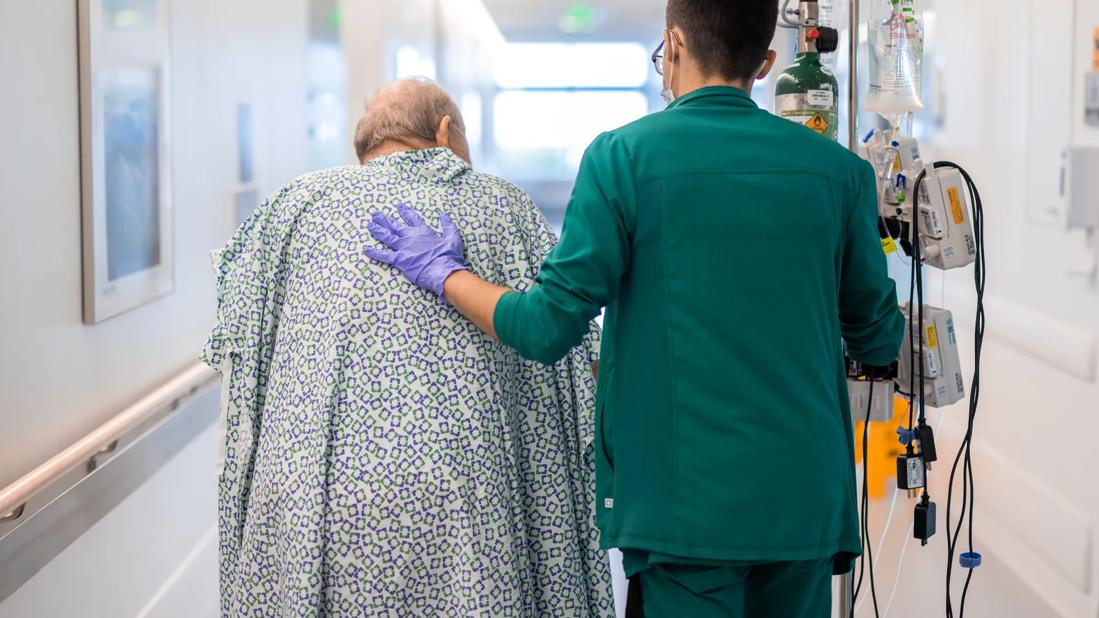Consultation team provides unit-based training

The many potential risks related to immobility in hospitalized patients include pressure injuries, pulmonary embolisms, deep venous thrombosis, muscle atrophy and functional decline. In spring 2021, Cleveland Clinic formed a consultation team to help encourage patient mobility.
Advertisement
Cleveland Clinic is a non-profit academic medical center. Advertising on our site helps support our mission. We do not endorse non-Cleveland Clinic products or services. Policy
“Our ultimate goal is to promote early progressive mobility of patients and maintain patient and caregiver safety,” says Kim Kalo, MSN, APRN, AGCNS-BC, OCN, who was recently named Cleveland Clinic’s first Program Manager of Mobility with Safe Patient Handling. She oversees the Mobility Consult Team, which includes clinical nurses, clinical nurse specialists, physical therapists and Cleveland Clinic’s director of environmental health and safety.
The Mobility Consult Team focuses its efforts on individual nursing units.
“We provide assessments and customized education at the unit level rather than teaching a class where you might have a mixed group – some ICU nurses, some med-surg nurses, some from observation – all with different needs,” says Kalo.
Nurse managers request consultations with the team and complete forms indicating the unit’s patient population, types of mobility devices currently in use, barriers to mobility and outcomes the unit wants to track. Outcomes might include the number of patient falls and pressure injuries or how often patients are mobilized.
Next, Kalo and another member of the team perform an assessment on the unit and look for potential gaps. Based on the assessment, they create custom training. “We spend time talking with caregivers about the importance of mobility and the impact it makes on patient care,” says Kalo. “We know outcomes are affected by how often a patient is able to get up and move.”
The Mobility Consult Team also provides hands-on training, demonstrating safe patient handling devices and equipment, such as overhead lifts, portable lifts and slings. Caregivers practice using the devices so they feel comfortable with them.
Advertisement
The training goes beyond instruction to cover logistical details, ensuring the units have a set place to store devices. “When nurses are ready to turn a patient or help them get up, we want them to have easy access to all the necessary equipment,” says Kalo.
Safe patient handling also benefits caregivers. In 2017, nurses were among the top three occupations with the highest rates of musculoskeletal disorders, according to the National Institute for Occupational Safety and Health.
“We know that caregivers perform physical jobs. We want to make sure they have the right tools to do their jobs safely and that they know how to use them properly to prevent injuries to themselves,” says Kalo.
To date, the Mobility Consult Team has received consultation requests from two intensive care units and four medical-surgical units across the health system. The group hopes to ramp up training when COVID-19 hospitalizations decline. “We want to provide more than just education,” says Kalo. “We are striving to create a culture of mobility.”
Advertisement
Advertisement

An unexpected health scare provides a potent reminder of what patients need most from their caregivers

Cleveland Clinic Abu Dhabi initiative reduces ICU admissions and strengthens caregiver collaboration

Veteran nurse blends compassion, cutting-edge transplant training and military tradition to elevate patient care

Embrace coaching and other tips to be a stronger leader

Compassion, communication and critical thinking are key

Study illuminates value of shared decision-making

How hospitals can weave ethics into daily nursing practice to strengthen patient-centered care

Mobility carts provide exercises and tools